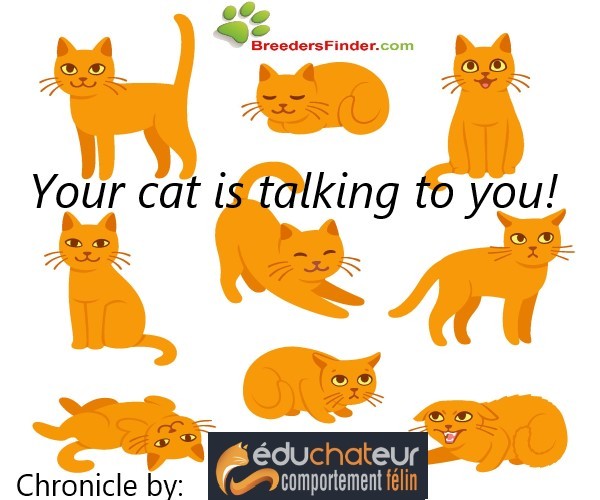
Your cat is talking to you ! - Éduchateur chronicle
- 05 Feb, 2021
- Tips
Your cat is talking to you !
Yes, the cat meows but is it really the only way he can communicate? Indeed, if meowing is a communication exclusively reserved for humans and often very much used by the cat, it represents only a small part of feline communication. As humans, we mainly use articulated language to communicate and on this basis, we tend to focus on our cats' vocalizations to understand them.
However, the cat primarily uses non-verbal language to communicate its state and emotions. It is therefore by paying attention to this language that we can better decipher our cat and optimize our relationship with him. Often, humans are bitten or scratched without understanding the reason, even though their cat had warned by its body language that something was wrong.
The cat uses his whole body to communicate. Its general posture is important but also the position of its ears, the dilation of its pupils and above all, the posture of its tail!
What is a happy cat? It is a relaxed cat with straight ears that tilt according to the sounds he hears. His vibes are normal as well as his pupils and he can have his tail in different postures. When the cat is in a positive excitement, his tail is straight, pointed towards the sky and can even wriggle with pleasure. The curious cat will also present a straight tail, in the air but with the tip slightly curved, like a question mark. When the cat is released, one can see its tail swinging slowly from right to left.
What is a frightened cat? It is a cat that will try to disappear. Its whole body is picked up, its neck is tucked into its shoulders and its pupils are dilated. Its ears and vibes are pressed against its head and its tail is stuck against its body, sometimes even against its belly, between its hind legs.
What is an assertive (or combative) cat? It is a cat that will, on the contrary, try to make himself as big and as impressive as possible. Its head comes out of its shoulders, it lowers its ears in the extension of its skull like airplane wings while bristling its hair and vibrating. His pupils are as fine as razor blades and his tail is stretched in the extension of his body or whips violently.
Certain details of body language can also help to detect a certain discomfort in the cat: these are signs of stress, formerly called signals of appeasement. They include blinking, yawning, nose licking, nervous grooming, tail whipping, drooping ears and dilated pupils. The cat who presents these signs is not at ease but this discomfort can be more or less important and one should not be alarmed at the slightest blink of the eyes. It is the context that allows us to measure the intensity of the emotion.
The cat hunting, a prey or a toy, can mix several indicators. The body is often picked up with dilated pupils but the tail forms a U or whip of excitement. The cat does not try to disappear, it becomes small but remains very attentive. It is therefore here again the context that will determine the intention.
The flare is a communication perfectly perceived by humans but often misunderstood. The human tends to identify it as a threat whereas it is above all a request for distancing. Faced with fire, reprimand is ineffective and even dangerous. As far as possible, it is advisable to look away and distance oneself. The cat only expresses its fear. If what is frightening him goes far enough away, the cat regains his calm.
The cat's communication is therefore much more developed and complex than simple meows. Meowing allows the cat to ask for attention or food while body language is used to express its emotional state. By paying attention to this language and responding positively to it, humans can better understand their cat and harmonize their relationship with it!
By Educhateur
Éduchateur is a team of feline behaviourists referred by more than 250 veterinary clinics in Canada and France since 2007. Every year, they help thousands of adopters to solve feline behaviour problems and understand their cats' needs in order to live in harmony with them.









